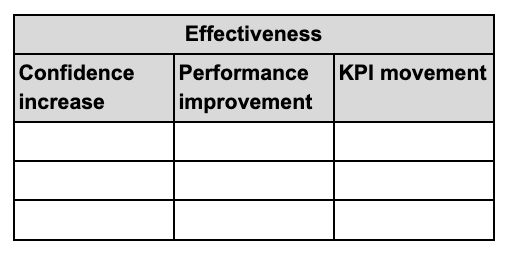Over the last few years, as an industry, we have rushed headlong into an era of investing significant budget, resource and effort into virtual, asynchronous learning formats, due to their scalability and apparent cost-effectiveness at a per-learner level. And that has led to all sorts of adjacent technology developments, like personalisation, video content creation, and now AI tools that surface the right learning… Of course, the Covid pandemic contributed significantly to accelerating many of these shifts, and the advent of digital platforms was always going to open up the possibilities for workplace learning to scale. But in some way, it feels like there’s proverbial tails wagging proverbial dogs with the direction we’re heading in.
We’ve seen this before, but with a significant difference – before I moved into L&D, I had a 25-odd year career in the world of media/marketing – a function and entire industry that was one of the earliest to be caught up in the seductive possibilities of digital transformation. When internet advertising first became possible, the earliest adopters quickly realised that digital advertising was incredibly powerful, effective, and efficient, and budgets flowed over a number of years to the new platforms, to meet the consumer where they are (last week, an old colleague shared that digital media is now 70% of all digital media advertising investment! I can remember the party when we achieved 1%!).
We could argue some parallels there with digital learning. The difference though is that the earliest pioneers in digital marketing were able to measure the impact/outcome of their marketing investment, and discovered it to be directly hitting the bottom line of their businesses. Entire $billion brands grew off the back of the impact of digital media. The same can’t possibly be said for L&D’s rush to digital platforms. This rush to digital platforms in Learning is not based on any real evidence that they perform any better than any other method. It seems to be more that they allow us “to do more with less” – but is this at the expense of outcomes?
You might argue that there are budget realities to be considered – or that we should be empowering learners in the workplace to learn at their own pace – surely pull has to be better than push, right?
I ask you this; which is better at achieving learning outcomes; learning retention; application; behaviour change; capability; performance; moving the needle on KPI’s?:
- Synchronous vs Asynchronous
- Classroom vs Independent learning
- Push vs pull
There’s very little evidence to support any true position in favour of any of these. The only area we might find some evidence is when comparing synchronous in-person vs synchronous virtual.
Here, the evidence suggests that learning outcomes aren’t significantly better in either.
At Cognitive Union, we think it’s crucial to recognise that not all learning methods yield the same results (by that, we mean proper results).
The thing is, many of the reasons we look at to assess the benefits of synchronous vs asynchronous interventions are helpful, but not the actual whole reason we are doing learning in the first place: scale, ease of access, reduced cost, self-driven, etc.
What about IMPACT? OUTCOME? Do people feel, think, or do differently as a result of what they have learned? Does the bottom line of the organisation improve because employees have learned valuable skills? There are some steps in the industry to bridge this measurement gap, but we are a long way from it being the norm.
At Cognitive Union, we believe that it is highly likely that synchronous learning and leadership workshops offer distinct advantages over their asynchronous counterparts. Critically, as well as benefits like fostering engagement, community & immediate feedback, we believe, most importantly, they drive more impactful outcomes.
The Gap in Research: From Education to Workplace Learning
Unfortunately, most existing research comparing synchronous and asynchronous learning focuses on the education sector, with scant attention paid to workplace learning. Despite this, insights from educational research provide valuable lessons for corporate training environments. Studies indicate that synchronous learning environments foster better engagement and immediate feedback, which are critical for effective learning【Source 1】[Source 2】[Source 3] [Source 4]
Cost Considerations in Corporate Training
The industry trend towards virtual asynchronous learning is driven by its scalability and lower costs. Asynchronous learning eliminates the need for physical venues, travel, and accommodation, making it a more economical option. However, it’s essential to balance these cost savings with the effectiveness and impact of the training. The ultimate goal of any learning program is to enhance performance, capability, and execution.
Probably because of a lack of evidence, all too often the calculation might go something like:

If we were to add a few more columns on the end of this sheet, we would advocate something like:

What we’re looking for here is to uncover the impact of the learning. If it costs more per head, but it impacts performance more, then we are getting closer to being able to allocate budget to drive results. We’d like to elaborate on this and explore it further in a subsequent post.
Why we believe Synchronous Learning Delivers Better Outcomes
1. Enhanced Engagement and Interaction
Synchronous learning creates an environment where real-time interaction is encouraged. Studies show that participants in synchronous settings report higher levels of engagement and satisfaction compared to those in asynchronous settings. Real-time feedback and peer interaction deepen understanding and retention of the material, crucial for improving workplace performance. [Source 5] [Source 6] [Source 1]
2. Building a Sense of Community
One of the significant benefits of synchronous learning is the sense of community it fosters. Real-time interaction helps build stronger connections among participants, critical in a corporate setting where teamwork and collaboration are paramount. Research highlights that synchronous learning facilitates organic conversations and immediate feedback, creating a more cohesive learning environment, which can lead to better team performance and morale【Source 7] [Source 8]
3. Immediate Feedback and Adaptability
In synchronous learning environments, instructors provide immediate feedback, crucial for correcting misunderstandings and reinforcing learning. This real-time adaptability enhances the learning experience and leads to better retention and understanding of the material. Immediate feedback is often missing in asynchronous formats, where delays can lead to prolonged periods of confusion and disengagement【Source 9】[Source 10]
4. Reduced Cognitive Load
Synchronous learning has been shown to reduce cognitive load compared to asynchronous learning. Lower cognitive load means participants can focus more effectively on the learning material without being overwhelmed, facilitating better processing and retention of information. This efficiency is critical for complex or intensive topics common in corporate training【Source 2]
5. Accountability and Participation
Synchronous learning environments promote accountability and active participation. When learners must attend and participate in live sessions, they are more likely to engage with the material and their peers. This sense of urgency and presence can drive higher levels of commitment and interaction, leading to more impactful learning outcomes. [Source 11] [Source 10]
Measuring the Impact on Performance and Capability
The most important outcome of any learning program is its impact on performance, capability, and execution. Research indicates that synchronous learning environments, by fostering higher engagement, immediate feedback, and stronger community bonds, significantly enhance these outcomes. Participants are more likely to retain information, apply what they’ve learned, and perform better in their roles. In the corporate context, this translates to improved productivity, better team collaboration, and enhanced overall performance. [Source 12] [Source 13] [Source 14]
A quick couple of caveats
- We are not entirely dismissing synchronous learning, nor are we ignoring the obvious benefits of a blend of the two approaches. We are, though, advocating more evidence on the correct balance and usage.
- We are also aware that very little of the papers that are available on this topic are related to workplace learning. We think that’s crazy and it needs to change.
So what do we do now?
While asynchronous learning offers flexibility and cost savings, the benefits of synchronous learning in terms of engagement, community building, immediate feedback, and reduced cognitive load cannot be overstated. For corporate training and development, where the goal is to enhance performance and capability, synchronous learning and workshops are better for delivering outcomes.
We aren’t advocating to stop creating asynchronous learning content at all. We’re mainly suggesting that we should think twice about putting too much of our budget, effort, and time into this great rush to asynchronous learning, when the evidence is actually a little thin that it works!
We’re committing ourselves to keep on exploring this topic, and we’ll continue updating you on it over the coming weeks. If you’d like to get involved, please drop me a line. We’d be delighted to find a way forward and get a better understanding of the correct balance.

